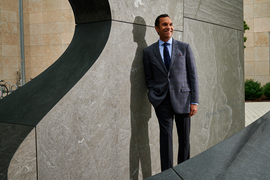MIT has released a new strategic action plan for belonging, achievement, and composition, intended to help the Institute forge a stronger sense of community and pursue excellence by tapping into talent globally.
The plan provides an Institute-wide framework for advancing diversity, equity, and inclusion across MIT, while allowing individual departments, labs, and offices to define and tailor their own efforts in this regard.
“Yet as in many academic communities across the country, even after decades of effort, there is essential work still ahead to make sure that everyone who earns a place here feels welcome,” MIT President L. Rafael Reif wrote in a letter to the MIT community about the plan. “The plan we share today draws on best practices from the past but in a way that is far more coordinated, while allowing opportunities for new thinking.”
Broadly, the plan’s aims are threefold: to enhance a sense of belonging at MIT, in the form of a connected community; to support achievement, by providing equitable opportunities; and to support a diverse campus population to help ensure MIT continues to be a magnet for the very best students, staff, faculty, and postdocs from across the world.
“This plan is really focused on the people who make up the MIT community,” says John Dozier, MIT’s Institute Community and Equity Officer (ICEO), who oversaw the creation of the strategic action plan. “We want everyone to feel like MIT is a place that is invested in helping them succeed. The plan is designed to help create the conditions for every member of the community to make their very best contributions to the Institute’s mission.”
Speaking the language of MIT
Today’s release of the strategic action plan follows a nearly two-year process of gathering ideas, reviewing past efforts, soliciting community feedback, and studying data. Starting in the fall of 2020, Dozier, Deputy ICEO Maryanne Kirkbride, and Associate Provost Tim Jamison convened the Strategic Action Plan Steering Team, a committee of three dozen faculty, staff, graduate and undergraduate students, and postdocs. They surfaced a list of 170 ideas for action — some based on previous reports to the Institute, others completely new — and released a draft of the plan in spring 2021. The steering team went on a listening tour to collect feedback from the campus, and held three dozen community engagement sessions on Zoom to collect direct feedback from people.
“The different perspectives from students to staff to faculty were absolutely crucial in creating this plan,” says John Fernández, a professor of building technology in MIT’s Department of Architecture, head of house at Baker House, and a member of the steering team. “There was no stakeholder that was not essential.” At times, he adds, “There was disagreement that required continued conversation, that then led to some resolution. That is the mark of a good committee, that there were diverse perspectives that did get worked out, and entered into the plan.”
That outlook is shared by students who served on the steering team.
“The Strategic Action Plan represents a significant commitment by the Institute, and one which is long overdue,” says Bianca Lepe, a PhD candidate in the Department of Biological Engineering and a member of the steering team. “I’m excited because it means that MIT is committed to resourcing both money and people to these issues, as well as making a public commitment to hold itself accountable to the goals it sets out.”
“What’s different about this plan is that it really tries to bring together the whole campus community in bringing about change,” says steering team member Yu Jing Chen ’22, who just earned her undergraduate degree from MIT and is starting graduate studies in the Department of Urban Studies and Planning. “You see that from the structure that emphasizes working with the local [campus] units to create their own plans. I think it’s really important that it’s not just something the central administration is saying it will do by itself.”
From the onset of their deliberations, Dozier and the members of the steering team worked to include a diversity of opinions, perspectives, and voices from the MIT community. They wanted the plan to reflect the unique qualities of the Institute.
“In our early discussions, we really tried to focus on how diversity, equity, and inclusion were understood and being put to work at MIT,” Dozier says. “What, exactly, did these words mean to people here? Was there anything different about them?” Those conversations, Dozier notes, led them on a path to reframing their work, and the plan, using slightly different terms.
Belonging, achievement, and composition are not synonyms for inclusion, equity, and diversity, Dozier notes. “But they resonated with us,” he says. “They made sense in a way that seemed more genuine, more like the language of MIT.”
How the plan is structured
The strategic action plan makes 13 specific commitments and lists more than 50 proposed actions the Institute will take across a wide range of domains. Some actions are intended to bolster existing Institute practices and operations; others create new resources for members of the community. The Institute’s senior leadership will work with the five schools and the MIT Schwarzman College of Computing, as well as major administrative and research units, to coordinate these initiatives.
“My hope is that the strategic action plan will transform the MIT community in a very positive way and make it a more inclusive place where some people who are not part of the dominant demographic feel more welcome, more involved, and more a part of the Institute,” says Asegun Henry SM ’06, PhD ’09, an associate professor and director of the ASE Research Group in the Department of Mechanical Engineering, and a member of the plan’s steering team. Even as a successful graduate student, Henry notes, he found MIT to be “extremely isolating.”
To help community members have a sense of belonging and support, the plan calls for, among other things, curricular innovations and funding for relevant academic research; the creation of a Wellbeing Lab; and improved coordination and communications about mental health resources.
To expand support in areas relating to achievement, the action plan calls for stronger undergraduate advising, a structured four-year alert system to signal when undergraduates may need academic help, more data about progression rates for graduate students, more professional development programs for postdocs and staff, and annual performance reviews for staff to acknowledge and support contributions to belonging, achievement, and composition.
The plan also calls for academic programs to document their graduate admissions processes and selection criteria and collaborate on best practices; support for Institute-wide recruitment activities for excellent students from underrepresented backgrounds; better coordination and expanded partnerships with minority-serving institutions; and the development of best practices for staff, faculty, and postdoc searches.
A “foundation” year to move forward
The action plan begins with a foundation year, a startup period during which “local” campus units and organizations — such as departments, labs, and major administrative units — will define or refine their own efforts and align their specific circumstances to the Institute’s broad aims.
“The foundation year is designed to help us create common ground and shared language,” says Kirkbride, who is also the director of MindHandHeart and has already been working closely with campus leaders on the plan’s implementation. “We want people to feel like they can accomplish these actions as part of how they do their work — not as an additional burden on top of what has been a very challenging couple of years.” To get there, “We need to work together, and we may need to rethink some of what we’re already doing,” Kirkbride adds.
“We really have two goals for the foundation year,” Dozier says. “First, we want to enable local conversations so people can consider their path forward. Second, we want every member of the community to feel like they are covered, like someone is helping plan for their success.”
Office hours with the ICEO
Dozier, Kirkbride, and Institute staff members are planning activities and programming throughout the academic year to support community members and leaders through the process.
Weekly drop-in office hours will start on Sept. 8. Dozier and Kirkbride have also been working closely with MIT’s new assistant deans for diversity, equity, and inclusion to help academic, administrative, and research units to engage with the action plan. This includes new tools, templates, trainings, and datasets to support planning at the local level.
“We can all appreciate that civil discourse, critical thinking, and empathy are at the core of how we create and sustain a sense of community at MIT,” Dozier says. “The plan is a complex and ambitious document, but these skills are really at its heart. This is how we create the environment that fuels our best work and supports the Institute’s mission.”
Past, present, and future
This is not the first time MIT has grappled with many of these issues, with some reports extending back a number of decades. For example, in 1999, the Institute released a report, “A Study on the Status of Women Faculty in Science at MIT,” following work by two successive committees, chaired by professor of biology Nancy Hopkins and professor of psychology Mary C. Potter; the report found serious inequities in the resources available to female faculty members.
In 2010, MIT issued its “Report on the Initiative for Faculty Race and Diversity,” following a committee assessment led by professor of chemical engineering Paula T. Hammond; that report found limited progress in many areas of MIT life concerning underrepresented faculty members.
Building on that important prior work, the current strategic action plan seeks to spur Institute-wide change in which MIT realizes long-held goals, with the central administration working in concert with individual units. In this sense, enhancing diversity, equity, and inclusion at MIT is not simply directed from above, or left to smaller, unsupported units. Rather it is a collaboration that can be driven from many directions.
“The goal is for the plan to be owned by everyone in the community,” says Chen. “There is a part for everybody to play in making MIT a more inclusive place, and there is a lot in which everybody can learn in this regard. This plan serves as a way for community members to not only learn about some of the challenges to equity MIT faces today, but also how we as an Institute plan to take action and how we as individuals come into it.”
Henry says: “It’s well-intended for sure. Based on the conversations that I’ve been a part of, I think there’s a genuine desire and intent for this to have a positive impact.”
Knowing the broad range of tasks and goals included in the strategic action plan, steering team members say they look forward to seeing MIT collectively work to weave the plan’s initiatives into its everyday practices.
“We’re taking in my opinion the crucial next steps in order to actualize it, rather than just talking about it,” Lepe says.












